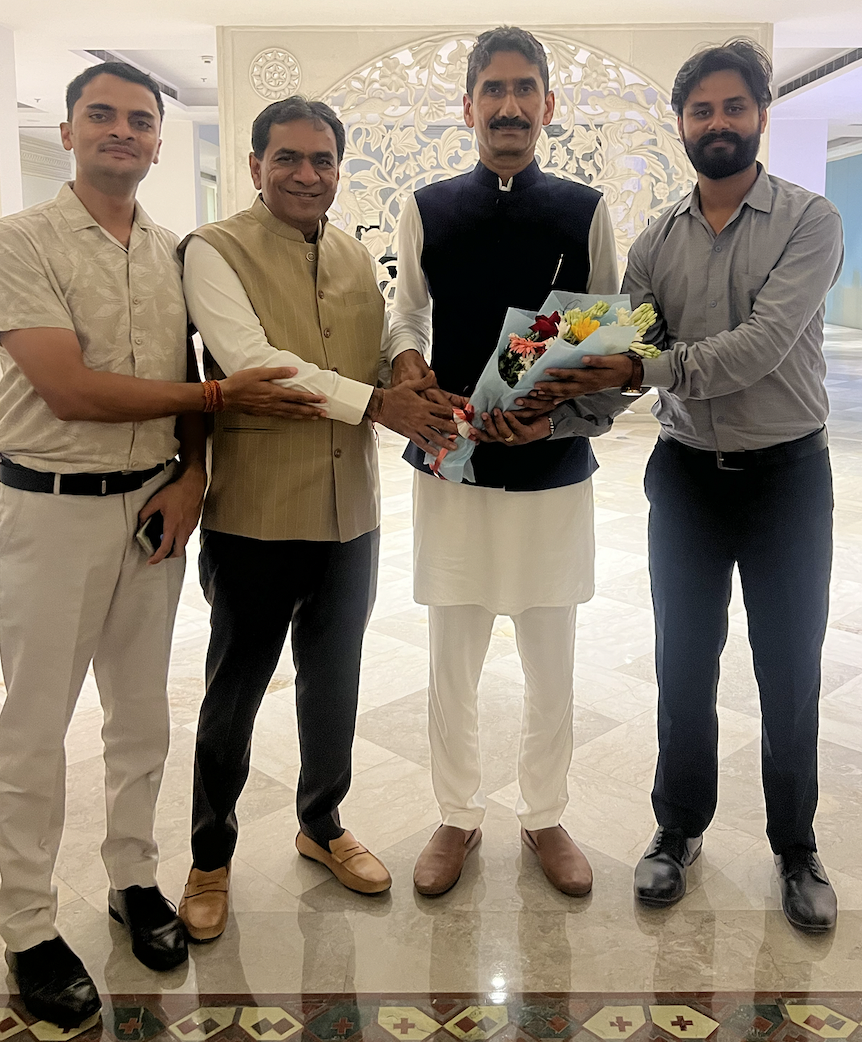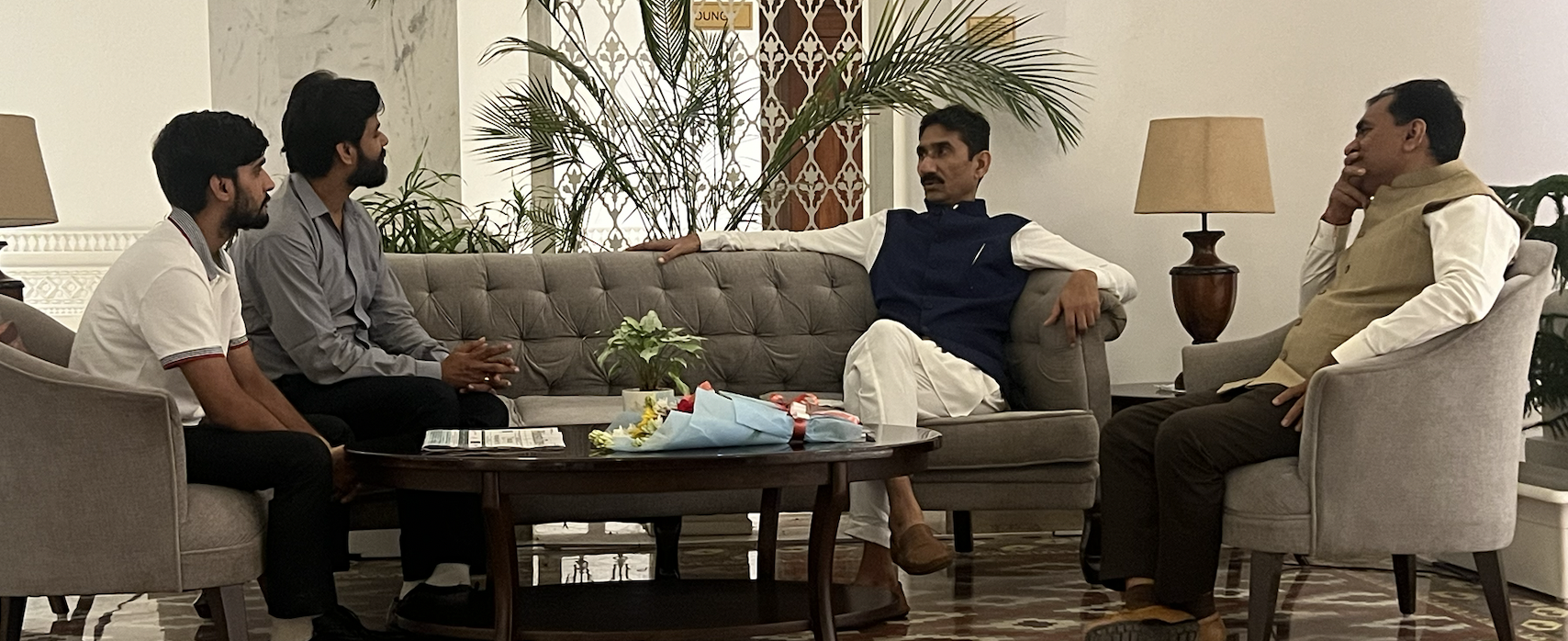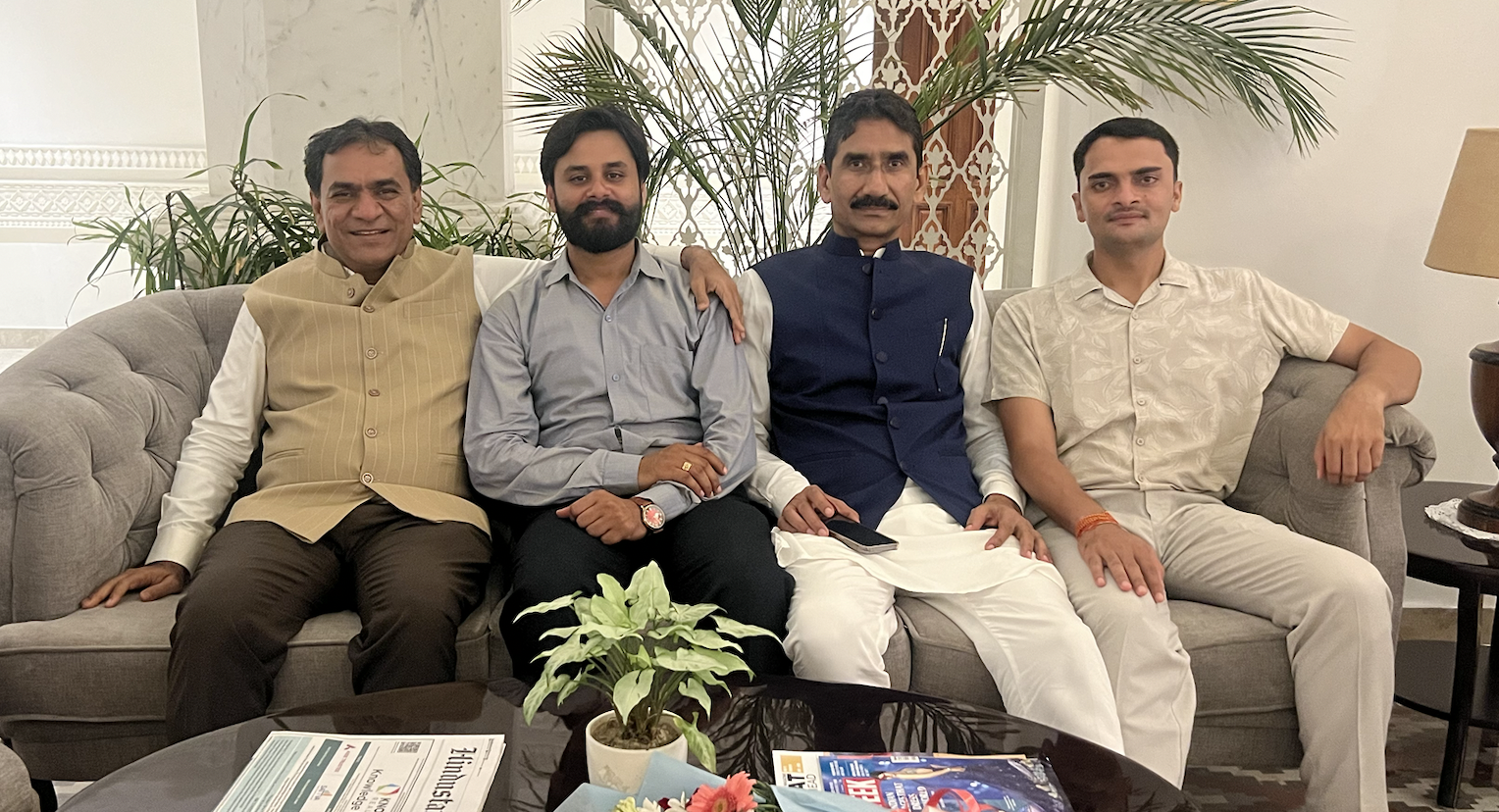Context: Why Gujarat Matters in Modern Yoga Revival
Gujarat occupies a vital place in India’s cultural landscape: its history of community institutions, educational initiatives, and civic engagement makes it an ideal laboratory for modernizing and scaling yoga. Over recent years, yoga has moved beyond a set of physical practices to become a multi-dimensional public-health, education, tourism and economic opportunity. With state-level leadership and collaboration between practitioners and policy-makers, Gujarat can build models that combine heritage preservation with evidence-based practice.
The meeting between Dr. Shivam Mishra, Yogsevak Seeshpal and MLA Pakash Varmora is therefore timely. It reflects a clear realization among stakeholders that institutionalizing yoga — through education, accreditation, public programs, and research — will require coherent policy, sustained funding, and mechanisms to ensure quality and safety. The trio explored how to weave yoga into school curricula, public health initiatives, vocational programs and cultural promotion without losing its essence.
A Meeting of Minds: Participants, Priorities and Immediate Outcomes
The meeting convened key leaders with complementary strengths. Yogsevak Seeshpal brought long experience from grassroots yoga activism and governance within the Gujarat Yog Board, while Hon. MLA Pakash Varmora offered political foresight and influence in provincial programs and legislative support. Dr. Shivam Mishra contributed academic credibility, international experience in yoga program scaling, and practical implementation strategies.

Participants prioritized several immediate steps: launching pilot yoga centers in districts with demonstrated need, establishing teacher-training hubs with standardized curricula, mapping existing resources across municipalities, and designing a public communication campaign that destigmatizes therapy-based yoga and highlights accessible practices for diverse populations.
Education & Accreditation: Professionalizing Yoga Teaching in Gujarat
One major theme was the need to professionalize yoga teaching while preserving diverse lineages and traditions. The meeting recommended a two-tier accreditation system: foundational certification for community instructors and advanced accreditation for therapeutic, research and teacher-trainer roles. This approach would enable mass training to meet demand while ensuring a pathway for high-quality specialization.
Recommendations included harmonizing curriculum across training centers, emphasizing anatomy, physiology, injury prevention, adaptive practices for special populations, ethics, pedagogy and basic research literacy. A registry of accredited teachers maintained by the Gujarat Yog Board would help employers, schools and healthcare facilities identify credentialed instructors.
Integration with Public Health and Community Care
Dr. Mishra emphasized integrating yoga into preventive and rehabilitative health services. Suggested pilots would place yoga therapists in primary health centers (PHCs) and community health outreach programs in partnership with the Department of Health. For chronic conditions — such as diabetes, respiratory ailments, cardiac rehabilitation and mental health — carefully designed yoga modules could augment conventional care, reduce symptom burden, and improve quality of life.
To ensure safety and efficacy, the meeting recommended creating clinical-advisory panels involving physicians, physiotherapists and certified yoga therapists to supervise program protocols and referral pathways. Outcomes would be tracked using standardized metrics including patient-reported outcomes, functional measures, and adherence rates.
Rural Outreach & Social Inclusion
Gujarat’s demographic diversity and rural-urban mix require targeted outreach. The leaders discussed mobile yoga camps, village-level volunteer networks, and inclusion of women’s self-help groups (SHGs) as partners in disseminating practices that are culturally acceptable and time-efficient for agrarian communities.
Programs would be adapted to seasonal work cycles — short sessions during harvest, community sessions integrated into local festivals and mother-child yoga practices for maternal health. Crucially, the vision prioritized women and elderly populations who often lack access to structured wellness programs.
Yoga Tourism: Cultural Promotion and Economic Opportunities
Gujarat’s cultural festivals, pilgrimage circuits, and scenic coastal and rural landscapes present a unique opportunity to develop yoga tourism. The meeting explored curated packages that pair authentic yoga experiences with cultural itineraries — Ayurveda consultations, heritage walks, local crafts workshops and farm-stay wellness retreats. These products would create livelihoods, support regional economies and attract domestic and international visitors.
Standards for yoga tourism operators were discussed — certification for retreat centres, transparent pricing, trained staff for safety and first-aid, and partnerships with local communities to ensure benefit-sharing. Branding Gujarat as a responsible yoga destination, rather than a commodified wellness market, was emphasized as both ethical and sustainable.
Curriculum, Schools & Youth Engagement
Embedding yoga in school routines was a recurring recommendation. The meeting suggested modular curricula for primary, middle and secondary levels that incorporate age-appropriate asanas, breathing exercises, mindfulness, and character education based on ethical principles associated with yogic practice. Teachers could receive short in-service training to lead daily practice and spot early signs of poor posture, stress or anxiety among students.
Beyond physical practice, youth engagement would feature leadership programs that train adolescents as peer-instructors, combining vocational skills with community service. Inter-school yoga olympiads and communication campaigns could nurture pride in heritage while promoting healthy lifestyles.
Research, Evidence and Academic Collaborations
Dr. Mishra highlighted the need for evidence-based programs. He proposed partnerships with Gujarat’s universities and medical colleges to establish a research consortium that studies yoga’s effects on common health conditions, stress, cognitive function and workplace productivity. Research priorities include randomized controlled trials, implementation science, qualitative studies on cultural acceptability, and cost-effectiveness analyses for public programs.
Data-sharing frameworks, ethical review boards, and trained research coordinators were recommended to ensure scientific rigor. Research findings would inform policy, optimize curriculum, and build the credibility necessary for large-scale public investment.
Digital Delivery & Tele-Yoga
In recognition of geographic constraints, the leaders discussed hybrid delivery models — in-person classes complemented by digital modules. A state-supported tele-yoga platform could host certified short practices, therapeutic modules, and resources for caregivers. Local nodes — community centers and libraries — could provide internet access and supervised sessions for those without home connectivity.
Digital offerings would be multilingual and accessible, featuring closed captions, audio-only formats for low-bandwidth users, and downloadable primers for offline use. A central portal managed by the Gujarat Yog Board could maintain quality control and a clear accreditation link between online content and live instruction.
Teacher Welfare, Employment & Livelihoods
To sustain a workforce of qualified instructors, the meeting outlined measures for teacher welfare: fair remuneration for public programs, micro-grants for startup community centers, pension or social-security options for senior teachers, and continuing education subsidies. A placement portal could connect credentialed teachers with employment opportunities in schools, hospitals and tourism centers.
Micro-entrepreneurship models were proposed to support rural trainers: small grants for mats, portable props, and basic marketing; incubation of teacher-led wellness cooperatives; and small-business training on bookkeeping and client relationship management.
Policy Instruments and Funding Mechanisms
Policy levers discussed included targeted grants for underserved districts, tax incentives for accredited yoga retreats, public-private partnerships (PPPs) to scale teacher training, and seed funding for research centers. The meeting also explored leveraging national schemes and corporate social responsibility (CSR) funds to co-finance community programs.
A draft roadmap suggested phased investments: initial pilots (year 1), evaluation and scale-up (years 2–3), institutionalization into state health and education budgets (years 4–5). Clear accountability indicators and a monitoring dashboard were recommended to ensure transparency and impact measurement.
Quality Assurance and Safety
Ensuring safety was a top priority. The meeting recommended mandatory basic first-aid training for all teachers, referral protocols to local health facilities, and risk-assessment checklists for classes catering to special populations (pregnant women, seniors, people with chronic illness). A complaint-resolution mechanism and an online registry of certified teachers and centres would create accountability and public trust.
Inclusion: Language, Culture and Accessibility
Gujarat’s linguistic diversity informed the decision to produce materials in Gujarati, Hindi and English, with local dialects as needed. Visual and audio resources would be sensitive to cultural norms and gender dynamics, and accessible formats (large text, audio narration) would be available for visually impaired participants.
Monitoring, Evaluation and Learning (MEL)
The group drafted a MEL framework with indicators spanning reach (number of beneficiaries), quality (teacher accreditation rates), outcomes (health status improvements), and equity (coverage across gender, caste, urban/rural). Periodic third-party evaluations were recommended to ensure objective assessment and course correction.
Community Stories: Pilot Case Studies
To inspire scale-up, the meeting identified pilot locations in Surendranagar, Bhavnagar and Kutch. Each pilot would document community stories — mothers using yoga for prenatal wellbeing, farmers practicing breathing techniques for stamina, and school children showing improved concentration. These case studies would be disseminated through local media and social channels to build public support.
Capacity Building: Trainer-of-Trainers (ToT) Model
A Trainer-of-Trainers model would accelerate capacity building. Senior teachers would mentor local trainers in pedagogy, adaptive sequences, and monitoring. The ToT program would include practical assessments and practicum placements. Certificates awarded upon completion would be recognized across districts to facilitate mobility of skilled trainers.
Public Engagement and Advocacy
Public engagement strategies include awareness campaigns during national health weeks, collaborations with influencers and cultural figures, and community competitions that celebrate local styles of practice. Advocacy would highlight evidence of yoga’s benefits while discouraging exaggerated health claims to maintain credibility with medical professionals and the public.
Interdepartmental Coordination
Effective roll-out requires coordination between departments: Health, Education, Tourism, Rural Development, and Women and Child Development. The meeting proposed a multi-stakeholder steering committee chaired by a senior state official to ensure cross-departmental alignment and efficient resource allocation.
Intellectual Property, Traditional Knowledge and Ethics
Respecting lineage and traditional knowledge was central to the discussion. The group stressed ethical acknowledgement of teaching lineages, proper attribution in curriculum materials, and careful handling of traditional practices to avoid commercialization that divorces them from context. Protocols for intellectual property of modern teacher-training curricula would be developed with stakeholder consultation.
Environmental Considerations
Yoga retreats and tourism must be environmentally responsible. Standards include waste management policies, local sourcing of food and materials, limits on visitor numbers in fragile ecosystems, and community benefit-sharing agreements. Sustainable practices would be a core part of branding Gujarat as a mindful yoga destination.
Funding the Vision: Public-Private Models & CSR
Financing options explored included PPPs for infrastructure, CSR partnerships for community pilots, microfinance for teacher-entrepreneurs, and earmarked state funds for research. A revolving fund to support community centers in low-income areas was proposed to ensure continued operations after seed grants expire.
Legal & Regulatory Framework
The meeting considered whether legislative backing is needed for teacher accreditation and safety standards. While immediate action could proceed through board resolutions and administrative rules, medium-term options include state-level guidelines or legislation that enshrine minimum training requirements and consumer protections.
Measuring Economic Impact
Beyond health outcomes, the leaders discussed economic metrics: jobs created, tourist spending, micro-enterprise revenues and reduced healthcare costs through preventive interventions. A proposed cost-benefit analysis would inform scale-up decisions and attract investor interest.
Communication Strategy
A comprehensive communication plan would use local radio, newspapers, social media, short documentaries and photo-stories to showcase impact. The messaging would be simple — “Yoga for Life, Yoga for All” — and emphasize accessibility, safety, and measurable benefits.
Timeline & Roadmap
The draft timeline outlined a five-year horizon:
- Year 1: Pilot programs, accreditation roll-out, research partnerships established.
- Year 2–3: Evaluation and scale-up in additional districts, launch of youth programs and tourism pilots.
- Year 4–5: Institutionalization in state policy, integration into public health/education budgets, statewide coverage expansion.
Risk Management
Risks such as poor quality teaching, safety incidents, funding shortfalls, and political changes were examined. Mitigation measures include transparent procurement, emergency protocols, diversified funding, and bipartisan advocacy to sustain programs across electoral cycles.
Partnerships & International Linkages
Dr. Mishra proposed linking Gujarat programs with international yoga and health institutes for exchange, joint research, and best-practice transfer. Exchange programs for teachers and researchers can accelerate capacity building and raise Gujarat’s profile on the global yoga map.
Technology & Data Privacy
Digital platforms must adhere to privacy and security norms. The meeting recommended simple consent procedures, limited data retention, and secure storage for participant records. A data governance policy would ensure ethical use of participant information for research and monitoring.
Measuring Wellbeing: Metrics Beyond Numbers
While quantitative indicators are important, the group emphasized qualitative measures: stories of improved family life, reduced stress in caregivers, and enhanced social connectedness. Community feedback loops would refine programs and keep them responsive to lived realities.
Voices from the Field: Local Leaders & Beneficiaries
Local stakeholders expressed enthusiasm: school principals reported calmer classrooms; SHG leaders noted increased community participation in health camps; and local healers welcomed respectful integration of yogic practices with traditional care. These voices affirmed that culturally adapted programs are most likely to succeed.
Commitments & Next Steps
Concluding the meeting, the trio committed to an actionable plan: (1) identify pilot districts; (2) finalize accreditation standards; (3) allocate initial seed funding; (4) convene a research consortium; and (5) launch a public communication campaign within three months. A follow-up meeting was scheduled to review pilot designs and finalize funding sources.
Conclusion: A Roadmap Rooted in Culture and Science
The meeting between Dr. Shivam Mishra, Yogsevak Seeshpal and Hon. MLA Pakash Varmora represents a forward-looking blueprint for yoga in Gujarat — one that respects tradition while embracing scientific rigor, social inclusion and economic opportunity. With clear leadership, robust partnerships and community-centred programming, Gujarat has the potential to become a global case-study in responsible, large-scale yoga integration.
As the pilots begin and research evidence accumulates, the state’s experience may offer lessons for other regions seeking to scale yoga as a public good — not merely as a private wellness commodity but as a holistic strategy for health, education, culture and sustainable livelihoods.

